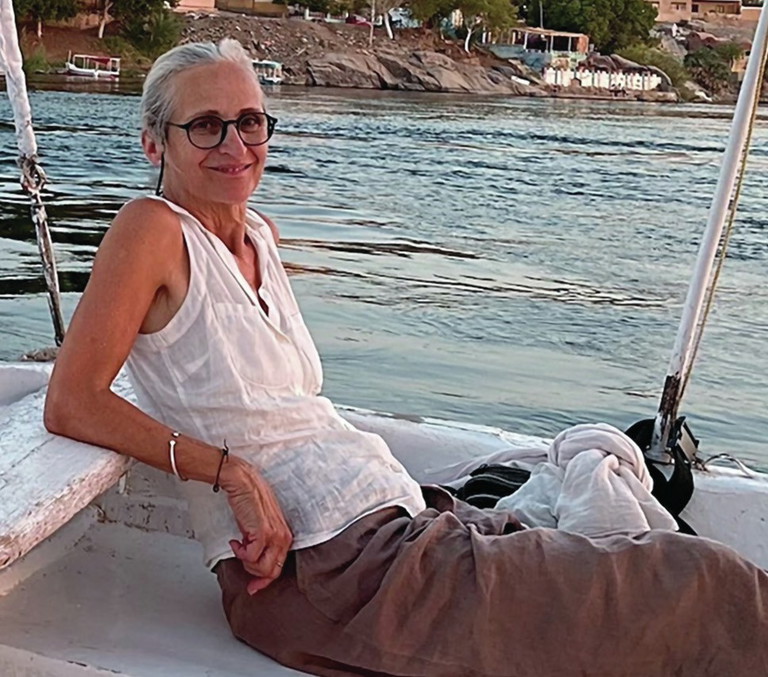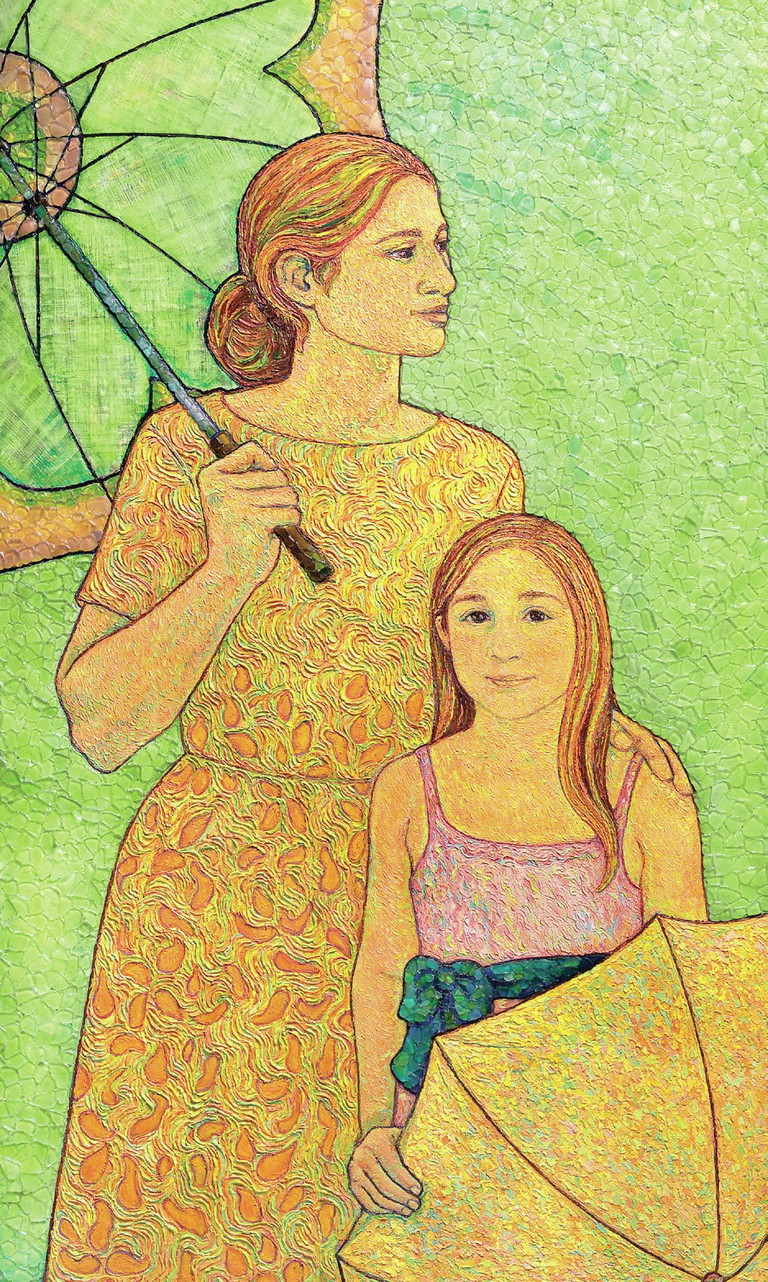CONTEMPORARY ART IN CONTEXT
Honoring Inner Strength
ROSA IBARRA PAINTER AND MIXED-MEDIA ARTIST

Painter and mixed-media artist Rosa Ibarra.
Rosa Ibarra is a Puerto Rican painter of people and portraits, mostly of women and children. She is inspired most by innocuous aspects of humanity: a gesture, a contemplative moment, a radiation of strength, or a quiet moment of connection between two people. Her imagery is made powerful by her attention to intimate details, and even more powerful by her use of mixed media to build up the richness of her surfaces and colors.
Artworks and Process
Ibarra’s paintings are fascinating combinations of rich personality, rich color, and rich surface. Inspired by people, especially strong women, she learns the most while observing her subjects in natural poses. Many of her portraits are tributes to women with an inner emotional strength, who have given their all to raise children and help others do the same. Her paintings elevate these unpresuming people in compositions where Ibarra adheres other elements to the oil painting to create a relief surface and contrast to the brushwork.

Rosa Ibarra, Eva. Mixed media, sea-washed glass, paper, and oil on canvas, 44 x 26" (112 x 66 cm). Image courtesy of the artist.
Ibarra chooses additional materials based on the sitter’s personality. In Mother and Daughter, she created a mosaic backdrop of sea glass that resembles Byzantine mosaics. She collects the sea glass in Old San Juan. In The Seated Muses, Luna, she used copper and silver leaf to frame her figure, an influence of Mesoamerican and South American Spanish Colonial painting. In The Missing Kernel, Ibarra’s work clearly channels the palette and brushwork of Vincent van Gogh (1853–1890).
Ibarra’s figures are created from a complex, “knitted” pattern of narrow strokes of brilliant color that resemble pointillism. They have a solid presence that is visually as exciting as the materials she adheres to her paintings.
The Missing Kernel. Diptych, oil on canvas, each panel 14 x 24" (35.5 x 61 cm).
Rosa Ibarra, Mother and Daughter. Mixed media, sea-washed glass, silver leaf, and oil on canvas, 36 x 30" (91 x 76 cm).
Art History: Mixed Media
Throughout art history, many world cultures have featured painting in all media combined with a wide range of objects and materials. In Western Europe, medieval manuscript illumination and painting were enhanced with gold and silver leaf, which was often laid over built-up stucco to create relief. In Asia, artists from many cultures used beetle wing casings, mica, and other natural materials to create decorative compositions. Western Dada, Surrealist, and Pop artists in the early to mid-1900s “revolutionized” paintings with the inclusion of found objects, a memorable example being Robert Rauschenberg’s (1925–2008) “combine paintings.” Today, many artists apply elements to their works, often in the spirit of recycling and sustainability, as in Ibarra’s sea glass paintings. Nick Gentry (b. 1980) is another standout example, often applying cut-up used CDs to his paintings.
About the Artist
Rosa Ibarra was born in Old San Juan, Puerto Rico, to an artistic family. Her father was internationally renowned painter Alfonso Arana (1927–2005), and her grandmother was a writer. She first learned to paint in her father’s art classes for children. After receiving a fine arts degree from the University of Massachusetts, Amherst, she worked in her father’s Paris studio as his assistant. She believes that art is her calling, and she shares her personal passion for both people and painting with marginalized communities through a variety of social projects, such as illustrating children’s books written by male inmates; teaching painting to cancer survivors, neurodiverse people, and recovering addicts; and presenting art to young women in prison. She is committed to the idea that art can touch people’s spirits at any age. In 2013, she was selected by the US Department of State’s Art in Embassies program to conduct workshops and lectures. She taught painting to teenagers recovering from drug and alcohol abuse in Latvia, lectured at the Art Academy of Latvia in Riga, and painted with children aged three to twelve in an orphanage.
Rosa Ibarra, The Seated Muses, Las Musas Sentadas, Luna. Mixed media, copper and silver leaf, oil on canvas, 32 x 22" (81 x 56 cm). All images courtesy of the artist.
ARTIST Q&A
What are some of the biggest influences on your work?
RI: My father, the Puerto Rican painter Alfonso Arana, was my first art teacher, and I was inf luenced by his work at the beginning of my career. Other artists in my formative years are, among many, Vincent van Gogh, Paul Gauguin, and Diego Rivera. Murals created during the 1950s by Puerto Rican artist Tufiño and my father were helpful for my last project. I love to use silver and/or copper gilding on the backgrounds of my canvases, which is inspired by medieval panel paintings. I did a series of works using beads after returning from a trip to South Africa. I got the idea to use sea-washed glass from the beaches of Old San Juan after admiring the Byzantine mosaics and frescoes in Italy. In summary, I see my art influenced by experiences from everyday life and amazing works by artists and artisans from around the world over the course of history.
Do you paint your subjects from models, or do you use photographs, and why?
RI: Assertive women are colorful subjects for my paintings. Some I see from a distance, others I meet casually, and their strength strikes me. The camera allows me to capture those spontaneous moments in a frame to use later on as reference.
What visual art concepts and skills did you learn while in school (K–12) that are most helpful to you now?
RI: In school, I learned mostly crafts and enjoyed it very much. But the basics of drawing, composition, and color theory my father taught me; he was the best teacher I will ever have. He opened my eyes to see form and shadows and find the complementary colors ever y where. My love for art at a young age was awakened by growing up surrounded by my father’s paintings at home. My critical thinking was fostered by going to museums in his company where we would have so much fun analyzing everyone’s artworks!
If you could go back in time, what advice would you give yourself as an emerging artist?
RI: To complement my fine arts degree, I wish I had taken classes in marketing and business administration. Both, in my opinion, should be part of the curriculum at art schools. I also encourage aspiring fine artists to do a minor in art education, which opens up possibilities of employment anywhere in the US and abroad.
Can you tell us about your most recent project?
RI: My most recent work is the illustration of a children’s book titled Doña Fela’s Dream, The Story of Puerto Ricoʼs First Female Mayor, published by Little Brown Books for Young Readers. It has been a very exciting project. You can learn more about it here.
RESOURCE
Artist Website: rosaibarra.com
External Links Disclaimer: The content in SchoolArts magazine represents the views of individual authors and artists, selected for publication by the editorial team. The resources provided are to support the teaching of art in a variety of contexts, and therefore, links to external sources are included. As such, any linked content is not monitored by SchoolArts and should be previewed by a professional before sharing with students.
Written by Karl Cole, Art Historian and Curator of Images at Davis Publications. kcole@davisart.com